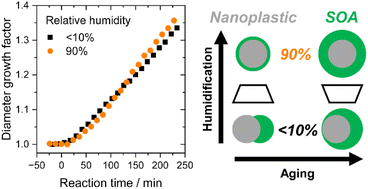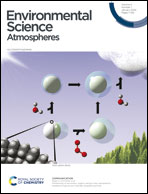Partitioning of secondary organic aerosol onto nanoplastics leading to hygroscopic partially-engulfed particles†
Abstract
Nanoplastics have been shown to be emitted into the atmosphere over land and the ocean and transported long distances to remote regions. During their atmospheric lifetime, nanoplastics may influence climate directly by absorbing and scattering sunlight and indirectly by enhancing ice or liquid cloud formation. Bare nanoplastics will not influence liquid cloud formation, since they are hydrophobic, but nanoplastics internally mixed with hygroscopic species during atmospheric aging have the potential to act as cloud condensation nuclei. Here, we report measurements of hygroscopic growth of initially 100, 200, and 250 nm polystyrene nanoplastics internally mixed with secondary organic aerosol (SOA) from the ozonolysis of α-pinene in a smog chamber. SOA formation and water uptake were quantified using parallel differential mobility analyzers at <10 and 90% relative humidity (RH), respectively. Interestingly, early in each experiment, at low SOA volumes, the mobility diameters of the humidified particles became smaller than those of the dry particles, despite certain water uptake. This discrepancy indicates that the particles at low RH have a non-spherical, partially-engulfed morphology. When they are humidified, the SOA takes up water, becomes less viscous, and coalesces around the nanoplastic, so the coated particles adopt a spherical morphology. Eventually, the SOA volume is high enough that the dry particles are also spherical, and the apparent volume of water scales linearly with the volume of SOA, as expected. A fit to measurements during this stage gives a hygroscopicity parameter of 0.02. Together, these observations have important implications on both the direct and indirect climate effects of nanoplastics in the atmosphere.

- This article is part of the themed collections: ES: Atmospheres Hot Papers and Urgent communications in RSC Environmental Science journals


 Please wait while we load your content...
Please wait while we load your content...